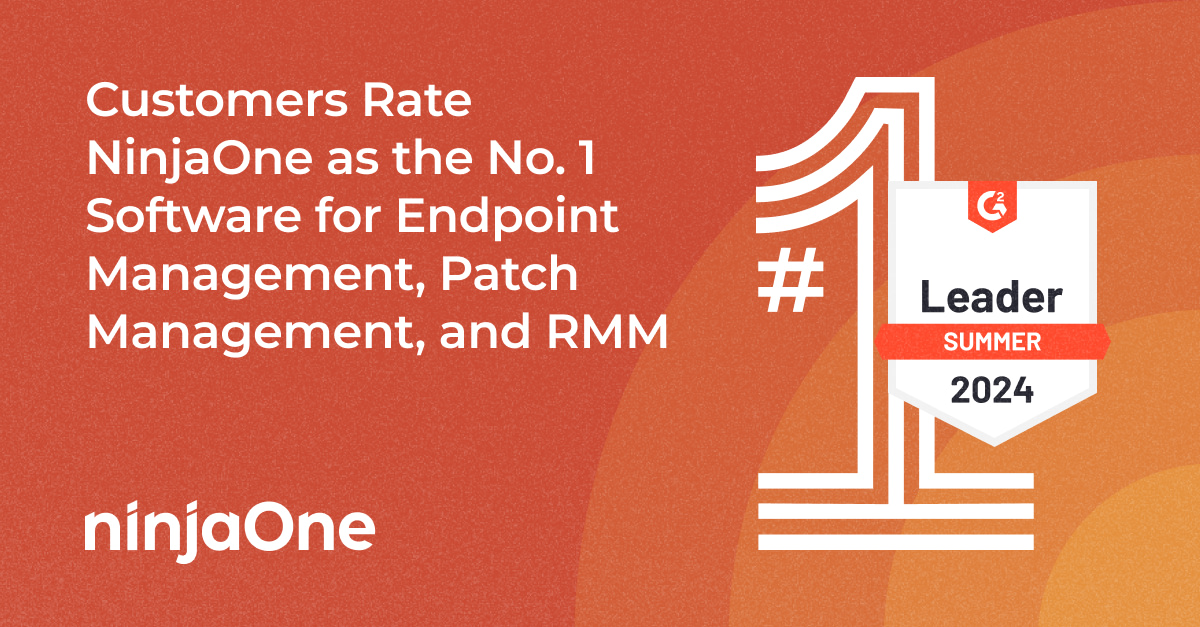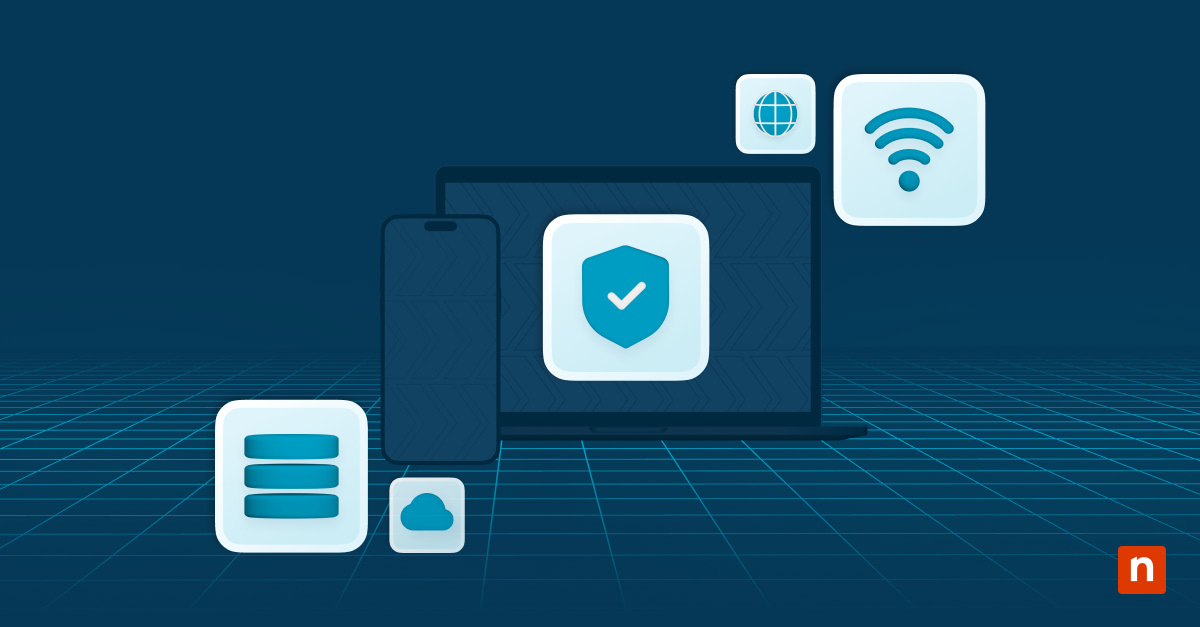Patch management is a key component in any functional, successful IT environment, and you can automate it to keep your IT estate healthy and more secure. In this article, we’ll discuss how to automate the patch management process to improve not only your operational efficiency but also strengthen your IT security strategy.
We recommend using this guide along with our other resources on the patch management process to gain a more in-depth understanding of the concept.
→ Master Patch Management with Automated Patch Deployment
5 steps to automate patch management
With the right patch management tool and a comprehensive IT inventory, setting up an automated patch management system will be easier than you think. Here’s how to set up automated patching in five simple steps:
1) Set up a patch management tool
If you have previously patched all devices manually, setting up and becoming familiar with your patch management tool might take some time. However, the right patch management tool should be intuitive with an easy-to-use interface so that you can begin automation right away.
2) Build a comprehensive network inventory
To patch all the endpoints in your IT environment, you need to know some specific details, such as how many endpoints are on your network, what types of endpoints you use, how many require patching, etc. The best way to gather and organize all this information is to create a comprehensive network and IT inventory. MSPs and IT departments use this inventory to manage hardware and software assets and to provide information about the current state of their IT environments.
3) Identify areas that benefit from automation
With a network inventory in hand and a patch management solution, it’s time to begin the automation process. Although you might not be able to automate all the stages in the patch management process, you can automate the majority of the main steps, such as patch deployment/scheduling, policy creation, and testing.
4) Set conditions and schedule automated patching
Now, it’s time to set up conditions and schedule automated patching for your systems. As you set up the automated processes, be sure to keep patching best practices in mind. For instance, if you are setting up automated patching for servers, it’s best to schedule the patching for after-work hours so that your other teams are not affected by the updates.
5) Monitor and ensure all patching systems function correctly
Even after patches are deployed, there’s still work to be done. In your patch management tool, you should be able to monitor your systems and ensure that all patches are deployed successfully. Use a unified RMM that includes patch management, such as NinjaOne RMM. You can also gain insight into device performance, health, security, and other endpoint information from a single pane of glass.
Why patch management is critical for IT
No organization is safe from the risks of unpatched software, from small businesses to large enterprises. In the first half of 2024 alone, we have seen a significant number of cyberattacks:
- Change Healthcare fell victim to a massive ransomware attack, described as the “most serious incident of its kind” in modern history (NBC News).
- Ascension Healthcare admitted that several files containing protected health information (PHI) and personally identifiable information (PII) were exfiltrated, with several of its servers being compromised in a ransomware attack (HIPAA Journal).
- CDK Global “almost certainly” paid a $25 million ransom after a “cyber incident” with BlackSuit disrupted thousands of data points (CNN).
Experts predict that threat actors will continue targeting as many security vulnerabilities as possible for the rest of the year and in the near future. That said, it’s worth noting that this also includes vulnerabilities caused by human error.
Only recently, CrowdStrike experienced a major outage related to an oversight in its software update, affecting around 8.5 million Microsoft devices worldwide. On July 19, 2024, millions encountered an error known as the “blue screen of death”, disrupting dozens of companies ranging from banks to airlines.
While patch management cannot completely eliminate these risks, it can create more efficient, successful, and productive programs, giving you more confidence to continue delivering quality services to your customers.
How automation plays a role in patch management
Automated patch management leverages automation to identify, download, and deliver software updates to selected devices across your entire IT infrastructure. As such, it can significantly reduce the time your IT staff spends on keeping your IT network healthy. With businesses producing and using an increasing number of endpoint devices every year, automated patch management is a more proactive approach to IT security, ensuring that critical patches are rolled out as soon as they are made available.
Manual patching vs. automatic patching
It’s tempting to say that automated patching is “better” for larger organizations, but manually patching updates also has advantages. Let’s summarize the most salient points:
| Pros | Cons | |
| Manual |
|
|
| Automatic |
|
|
Why automate patch management?
In the current digital landscape, organizations face a constant balancing act between securing their IT environment and creating an effective and efficient patch management process.
As seen above, there are many advantages to manually patching updates to your entire fleet. However, more and more IT experts highly recommend automating the patch management process for the following reasons:
- It can reduce patching by 50%. Many automated patch management tools can cut patching by half, freeing your IT technicians to focus on more high-value strategic tasks. NinjaOne, for example, is consistently rated as the #1 in patch management because 93% of its customers saved time on patching, and 95% improved their patching compliance.
- It’s easy to set up. Today, patch management tools are plug-and-play, meaning that once installed, you can immediately access and use them. This eliminates any complicated configurations or onboarding and training processes.
- It allows you to patch at your pace. Automated patch management empowers you to deploy updates exactly when you want them. IT administrators can schedule patch batches to limit any possible organizational impacts and ensure optimal productivity.
- It strengthens your endpoint security. Automated patching solutions are typically part of any IT security checklist, as they play a significant role in maintaining a zero-trust architecture.
- It helps you meet your compliance goals. Automating the patch management process allows you to remain compliant with several regulatory policies, including GDPR, PCI, and HIPAA.
How does automated patch management work?
Automated patching usually follows a simple 4-step process:
- Patch discovery. Your patch management tool identifies new patches from various sources.
- Patch assessment. It then evaluates the relevance of these patches to your organization’s IT network.
- Patch deployment. The patch management tool automatically deploys the appropriate patches based on a predetermined schedule.
- Patch monitoring. It’s important that you continuously monitor the success of your patches and detect any inconsistencies or abnormalities.
Automated patch management benefits
Better security
Without a doubt, an automated patch management tool immediately takes your security to the next level. Using the advantages of automation, a patching tool ensures that every device in your IT infrastructure receives the security patches they need in a timely manner.
Reduce manual errors
Manual errors happen when patching is left entirely in human hands. Automated patch management allows users to set up patching schedules and ensure that updates are pushed uniformly to all endpoints without significant human intervention.
Greater efficiency & productivity
No one really wants to spend hours on patching. It’s tedious work that’s better handled by an automated system. After setting up an automated patch management tool, users notice an impressive boost in IT efficiency and productivity.
Simplify compliance reporting
For organizations that qualify for SOC compliance audits, such as MSPs, automated patch management is a great help since the automated systems produce patch reports. These reports are used in compliance audits to ensure that IT teams follow IT and security best practices.
Challenges to automated patch management
We’ve written a more extensive guide on the Top 5 Patch Management Challenges of 2024, but to give an overview:
Compatibility
Challenge: It’s vital that you ensure compatibility between patches and your existing software. Remember: Conflicts between the two can lead to performance issues or even a complete breakdown or outage of your entire IT estate.
Solution: The easiest and simplest way to reduce this risk is to test patches in a controlled environment before deploying them to your entire fleet.
Legacy applications
Challenge: As with compatibility, legacy applications may not support standard patch management tools.
Solution: Work with your patch management vendor to create custom solutions to ensure security updates are rolled out correctly.
Bandwidth
Challenge: Automated patch management requires sufficient network bandwidth and infrastructure.
Solution: Carefully consider your existing resources and schedule patch deployment properly to minimize any impact on network performance.
Why NinjaOne is your #1 solution for patch management
NinjaOne is an RMM and patch management tool that helps IT departments and MSPs create a safer, more unified IT environment.
Trusted by 17,000+ customers worldwide, NinjaOne automatically patches Windows, Mac, Linux OSs, and third-party apps and offers flexible patching schedules to ensure all endpoints are patched exactly when you want.
If you’re ready, request a free quote, sign up for a 14-day free trial, or take a tour.







